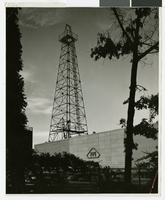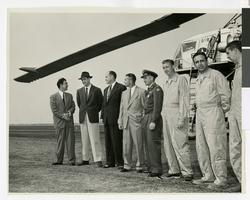Search the Special Collections and Archives Portal
Search Results
Landing of Howard Hughes's Lockheed 14 aircraft, New York, 1938 July 14
Level of Description
Archival Collection
Collection Name: Howard Hughes Public Relations Photograph Collection
Box/Folder: Folder 08
Archival Component
Landing of Howard Hughes's Lockheed 14 aircraft, New York, 1938 July 14
Level of Description
Archival Collection
Collection Name: Howard Hughes Public Relations Photograph Collection
Box/Folder: Folder 08
Archival Component
Landing of Howard Hughes's Lockheed 14 aircraft, New York, 1938 July 14
Level of Description
Archival Collection
Collection Name: Howard Hughes Public Relations Photograph Collection
Box/Folder: Folder 08
Archival Component
Landing of Howard Hughes's Lockheed 14 aircraft, New York, 1938 July 14
Level of Description
Archival Collection
Collection Name: Howard Hughes Public Relations Photograph Collection
Box/Folder: Folder 08
Archival Component
Landing of Howard Hughes's Lockheed 14 aircraft, New York, 1938 July 14
Level of Description
Archival Collection
Collection Name: Howard Hughes Public Relations Photograph Collection
Box/Folder: Folder 08
Archival Component

Photograph of the exterior of Hughes Research Laboratories, Culver City, California, circa 1940s
Date
Archival Collection
Description
Image
Howard Hughes and Edward Lund at the Newark, New Jersey airport, 1937 January 19
Level of Description
Archival Collection
Collection Name: Howard Hughes Public Relations Photograph Collection
Box/Folder: Folder 02
Archival Component

Photograph of Howard Hughes and others with the XH-17 helicopter, Culver City, California, October 23, 1952
Date
Archival Collection
Description
Image
Hughes Electronics Corporation Records
Identifier
Abstract
The Hughes Electronics Corporation Records (1935-2021) contain the files and publications of the corporate communications department and records donated by Robert K. Roney, a leading engineer at Hughes. These records document the growth of the company in Southern California, from building experimental aircraft for Howard Hughes, to developing and manufacturing radar and guided missile systems for the United States military and NATO forces, to developing and manufacturing communication satellites and space probes for NASA, and becoming the largest manufacturer of communication satellites and provider of satellite TV. The collection contains press releases, executive biographies, executive speeches, annual reports, corporate directories, organizational charts, correspondence files, technical reports and notes, promotional materials, as well as articles and publications detailing the history of the company. The collection also includes audiovisual materials and photographs. The audiovisual series details the history of the company through news footage and documentaries about Howard Hughes, aviation, corporate mergers, interviews with executives and promotional videos.
Archival Collection
Lockheed 14 aircraft over New York City, 1938 July
Level of Description
Archival Collection
Collection Name: Howard Hughes Public Relations Photograph Collection
Box/Folder: Folder 06
Archival Component
